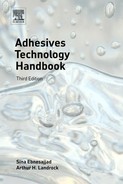Preface to Second Edition
I was asked by the publisher to update Arthur Landrock’s Adhesives Technology Handbook, which was first released in 1985 by Noyes Publishing. I have taken advantage of almost every bit of the material in the Landrock book by updating, revising, and including them in the present book.
There are many books about adhesives. Several excellent books are available that deal with the subject of adhesives from different points of view. Some have looked at adhesives from synthesis, chemistry, or bonding techniques points of view. Others have treated the subject from a practical standpoint. Of these, most are attempts to describe adhesion to a variety of materials including plastics, metals, wood, etc. A few books are highly specialized in the applications of adhesives in a particular industry such as metals or construction.
What is different about this book? The present book is focused on practitioners of adhesion technology from an end user’s point of view, thus covering most substrates such as plastics, metals, elastomers, and ceramics. The information is aimed at allowing readers to select the right adhesive and successfully bond materials together. Every attempt has been made to enhance the accessibility of the information and the reader friendliness of the text. In the balance of practical and theoretical subjects, practical has been given a definite advantage. This is a trade-off that the author readily acknowledges. There are numerous good books and sources for the study of the theory and science of adhesion and adhesives.
The aim of this book is to explain in a simple yet complete manner all that is required to successfully bond different materials. This book is both a reference and a source for learning the basics for those involved in the entire product value chains. Basic principles of adhesion such as surface characterization, types of adhesive bonds, and adhesion failure topics have been covered in addition to a description of common adhesive materials and application techniques. This book offers information helpful to engineers, chemists, students, and all others involved in selecting adhesives and bonding materials together.
Every chapter has been arranged so that it can be studied independently as well as in conjunction with the others. For those who are interested in indepth information, numerous sources have been listed for surface adhesion and polymer science in the pertinent chapters. The references listed at the end of each chapter serve as both bibliography and additional reading sources. Most of the basic practical technology of adhesives was developed decades ago. Older references have been retained from the Landrock book wherever they represented the preferred source of information for a specific topic. Readers can find a wealth of information and reports that have been declassified by the Defense Technical Information Center (www.dtic.mil), most of which date back to the 1960s and 1970s.
The first three chapters discuss definitions, adhesion theories, surface characterization and analysis, surface energy measurement methods, adhesion mechanism, failure modes, and surface treatment of materials.
Chapters 4–6 describe the adhesives available from a materials standpoint. In Chapter 4, adhesive classification in a number of ways has been described according to the source, function, chemical composition, physical form, and application. Chapter 5 discusses individual adhesive types in detail. As a matter of convenience, the adhesives have been arranged in alphabetical order. Chapter 6 describes adhesives for specific adherend types.
Chapter 7 is devoted to the design of joints. Chapter 8 describes the methods of handling, storage, and application of adhesives to substrates. Solvent cementing has been covered separately in Chapter 9 because of its significance. Chapters 10–12 focus on the methods of testing the strength and durability of adhesive bonds, and quality control assurance.
Chapter 13 deals with economic, environmental, safety, and future trends.
None of the views or information presented in this book reflects the opinion of any of the companies or individuals that have contributed to the book. If there are errors, they are oversight on the part of the author. A note indicating the specific error to the publisher, for the purpose of correction of future editions, would be much appreciated.
